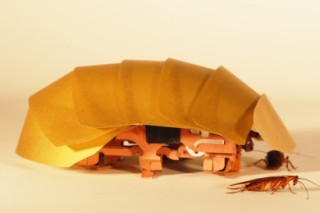Feb 9 2016
Our fear and disgust that cockroaches can quickly squeeze through the tiniest cracks are well-justified, say UC Berkeley scientists.
 The CRAM robot, inspired by cockroaches, can crawl even when squashed to half its size. Photo by Tom Libby, Kaushik Jayaram and Pauline Jennings. Courtesy of PolyPEDAL Lab UC Berkeley.
The CRAM robot, inspired by cockroaches, can crawl even when squashed to half its size. Photo by Tom Libby, Kaushik Jayaram and Pauline Jennings. Courtesy of PolyPEDAL Lab UC Berkeley.
Not only can they squish themselves to get into one-tenth-of-an-inch crevices, but once inside they can run at high speed even when flattened in half.
UC Berkeley biologists have found robotic inspiration in the creepy ability of cockroaches to squeeze through even the tinniest crack. Video by Roxanne Makasdjian and Stephen McNally, with footage and photos by Tom Libby, Kaushik Jayaram and Pauline Jennings. Courtesy of PolyPEDAL Lab UC Berkeley.
These are just a couple of the creepy findings from a UC Berkeley study of how American cockroaches (Periplaneta americana) penetrate the tightest joints and seams in less than a second.
What the researchers found has inspired a robot that can rapidly squeeze through cracks — a new capability for search-and-rescue in rubble resulting from tornados, earthquakes and explosions.
“What’s impressive about these cockroaches is that they can run as fast through a quarter-inch gap as a half-inch gap, by reorienting their legs completely out to the side,” said study leader Kaushik Jayaram, who recently obtained his Ph.D. from UC Berkeley and is now a postdoctoral fellow at Harvard University. “They’re about half an inch tall when they run freely, but can squish their bodies to one-tenth of an inch — the height of two stacked pennies.”
Cockroach robots to the rescue!
This is a demonstration of the compliance of the CRAM robot's shell, passive sprawling mechanism of flexible spine and a side view of our robot prototype running unrestricted and crawling in a confined space at 35 mm crevice height. Playback sequences are as indicated in video.CREDIT:Courtesy of PolyPEDAL Lab, UC Berkeley
Roaches traversing crevices, Jayaram found, can withstand forces 900 times their body weight without injury.
Using the roach technique as inspiration, Jayaram designed a simple and cheap palm-sized robot that can splay its legs outward when squashed, then capped it with a plastic shield similar to the tough, smooth wings covering the back of a cockroach. Called CRAM, for compressible robot with articulated mechanisms, it was able to squeeze into and run through crevices half its height.
“In the event of an earthquake, first responders need to know if an area of rubble is stable and safe, but the challenge is, most robots can’t get into rubble,” said Robert Full, a professor of integrative biology at UC Berkeley. “But if there are lots of cracks and vents and conduits, you can imagine just throwing a swarm of these robots in to locate survivors and safe entry points for first responders.”
Jayaram built the model robot using an origami-like manufacturing technique, now available as an inexpensive kit made by Dash Robotics — a commercial spin-off from previous robotic work at UC Berkeley. Now, more robust versions will be needed for real-world testing.
“This is only a prototype, but it shows the feasibility of a new direction using what we think are the most effective models for soft robots, that is, animals with exoskeletons,” Full said. “Insects are the most successful animals on earth. Because they intrude nearly everywhere, we should look to them for inspiration as to how to make a robot that can do the same.”
Jayaram and Full will publish their findings this week in the early online edition of the journal Proceedings of the National Academy of Sciences.
Animal locomotion
Over the past three decades, Full and students in his Poly-PEDAL lab have studied how animals walk, run, jump, glide, crawl and slither to understand the basic biomechanical principles that underlie locomotion, and that can be used to design better robots. Their findings have inspired robots with legs like those of cockroaches and crabs as well as sticky feet like those of geckos. Full, 25 years ago, discovered that American cockroaches can run on two legs – a feat certified by the Guinness Book of World Records – and can achieve a speed of nearly 5 feet per second, or 50 times their body length per second.
Using a high-speed camera, Jayaram filmed roaches running at nearly full speed between plates spaced a quarter-inch apart, less than the thinnest part of a roach’s body. By narrowing the slits, he found that they could slip through slits of one-tenth of an inch if highly motivated.
While squashed, they cannot properly use their feet, so they use the sensory spines on their tibia to push against the floor to move forward.
“They have to use different body parts to move in these spaces, because their legs and feet are not oriented to work properly,” Jayaram said. “But they are still capable of generating the large forces necessary for locomotion, which blew my mind.”
Jayaram attached sandpaper to the top and bottom of crevices to determine how friction affected their ability to move, and found that a smooth top shell and not too much floor friction were key, since the roach has to have sufficient friction to push forward, but not too much to slow it down. The researchers refer to this new mode of locomotion as “body frictional legged crawling with drag on the body,” since thrust by the legs is dominated by friction but there is no drag from flowing media, such as air, water or sand.
Jayaram is now testing all parts of the cockroach to determine their mechanical properties and their role in the bugs’ creepy crawling.
The work is supported by the Army Research Laboratory through the Micro Autonomous Systems and Technology (MAST), a Collaborative Technology Alliance involving industry, universities and the U.S. Army.